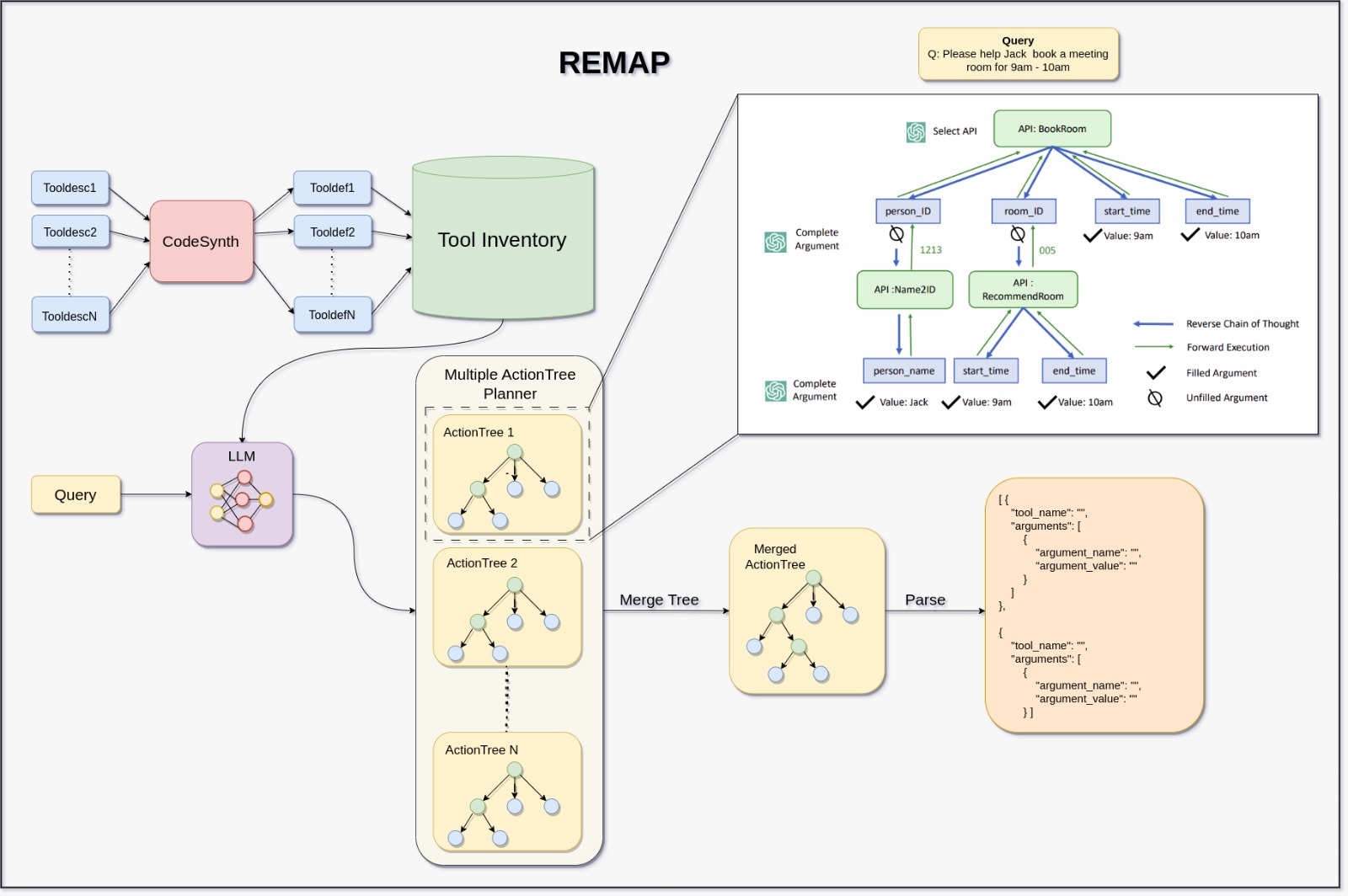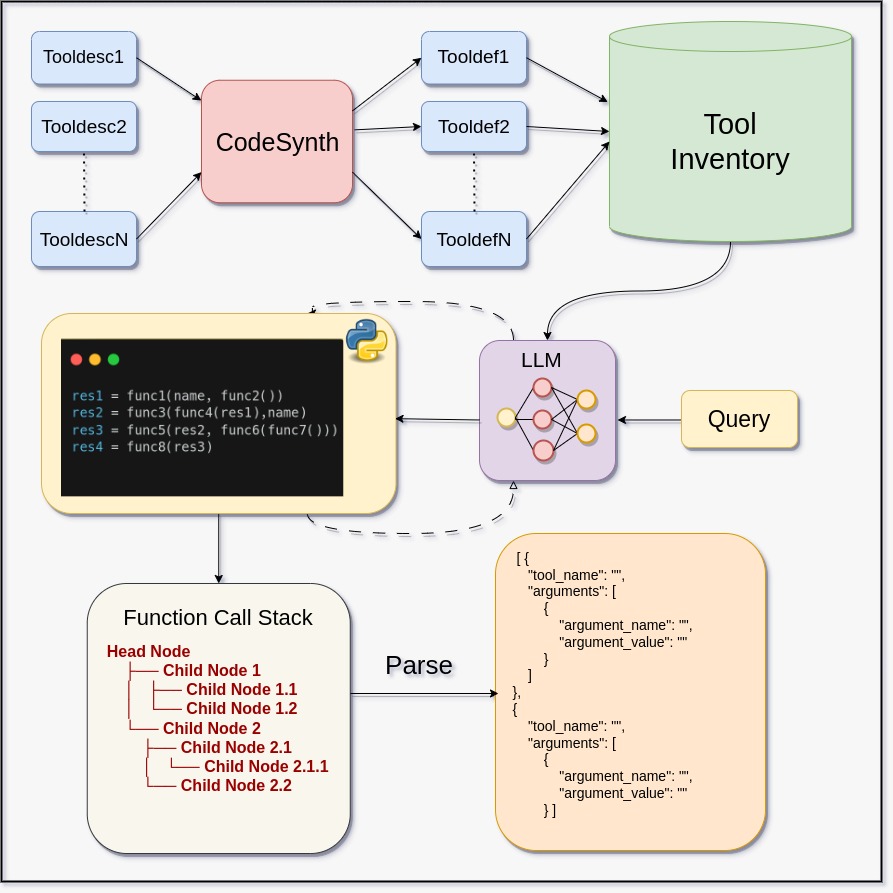Large Language Models augmented with Function calling capabilities have opened doors to a new paradigm of application development across various domains due to their ability to execute a user query by planning a chain of function calls only using their Natural Language Understanding.
$ pip install -e SwissNYF/$ python -m swissnyf.run_query --config ./config.yaml \
--tools ./tools.yaml \
--pipeline topgun\
--retriever instructxl\
--input ./input.txt\
--output ./output.jsonl\
--query "Prioritize the submission of the paper"\
--llm openai\
--verbose Trueusage: run_query.py [-h] [--config CONFIG] [--tools TOOLS] [--pipeline PIPELINE] [--retriever RETRIEVER]
[--input INPUT] [--output OUTPUT] [--query QUERY] [--llm LLM] [--verbose VERBOSE]
options:
-h, --help show this help message and exit
--config CONFIG Location of the config file, Defaults to our custom config
--tools TOOLS Location of the tools file, Defaults to basic tools
--pipeline PIPELINE Name of Pipeline options: topgun/reversechain
--retriever RETRIEVER Name of the retrieving technique options: gear / toolbench / instructxl
--input INPUT A txt file with queries you want to run, defaults to a set of queries
--output OUTPUT Output json file for solution, defaults to ./outputs.jsonl
--query QUERY If you do not want to run pipeline only on 1 query and do not pass input
--llm LLM Specify llm service provider Defaults to openai options: azure/openai
--verbose VERBOSE to turn on verbose
| Flag | Values | Description |
|---|---|---|
| tools | data/tools.yaml | tool descriptions |
| pipeline | reversechain/topgun | method to use for solving the query |
| retriever | gear/toolbench/instructxl | retrieval strategy |
| input | data/input.jsonl | file containing the queries |
| output | output.jsonl | output file |
| query | query | query string |
| llm | azure/openai | llm to be used |
| verbose | False/True | verbose |
Use this when you would like to add new secrets we have already loaded your secrets so please do not use until neccessary
$ python -m swissnyf.add_secretsThis opens a template of .env file with out the previous keys. If there was any previous keep this clears them. This is done through nano do not run on colab or notebook.
This is to edit your existing secrets we have provided or if you have changed use this command
$ python -m swissnyf.edit_secretsThis opens a the previously set secrets file to continue editting. This is done through nano do not run on colab or notebook.
This is to edit our default configs that we used for evaluation. Values are the same as given in configs so keep in mind and edit it based on it. You can override this through passing args in run_query
$ python -m swissnyf.edit_configs- This is done through nano do not run on colab or notebook.This is to edit your existing tool definition, you can overide this tools def by passing tools yaml in run_query. By setting it here by default these definitions will be used
$ python -m swissnyf.edit_tools- This is done through nano do not run on colab or notebook.The major constraints and challenges we faced are below:
- No API Definition: The solution operates without explicit function definitions, relying solely on tool descriptions.
- Dynamic Tool Integration: The platform adapts to API changes, additions, and removals, ensuring flexibility.
- Comprehensive Tool Coverage: The solution accommodates diverse tools, irrespective of popularity or type.
- Performant Inference: Real-time, robust inference is a prerequisite, optimizing LLM calls for efficiency.
- Accuracy: The code response must align accurately with the query for solution acceptance.
Hence, we have employed Reverse Chain, which employes effective use of API selection and argument filling for tool selection. It's pipeline consists of :
- Tool Inventory: Tools generated by CodeSynth via tool definitions.
- ActionTree: Tree build by Reverse Chain in reverse order of solution.
- Multi-ActionTree Planning: To address query with multiple independent tasks, use multiple action trees.
- Merge ActionTrees: LLM takes in multiple aciton trees and orignal query to build a final solution.
- Parsing: Merged Tree is pared into the JSON format in the correct.
and TOPGUN which relies on code generation capabilities of LLMs to effectively find solution to a query. It includes the following parts:
- Tool Inventory: Tools generated by CodeSynth via tool definitions.
- Code-Driven Reasoning: Instruct the LLM to generate a logical code using the correct combination of pseudo functions to solve the query.
- Function Call Stack: Stores the call sequence of the executable generated code, in a tree structure
- Parsing: Tree is parsed to obtain the final JSON format in correct order.

